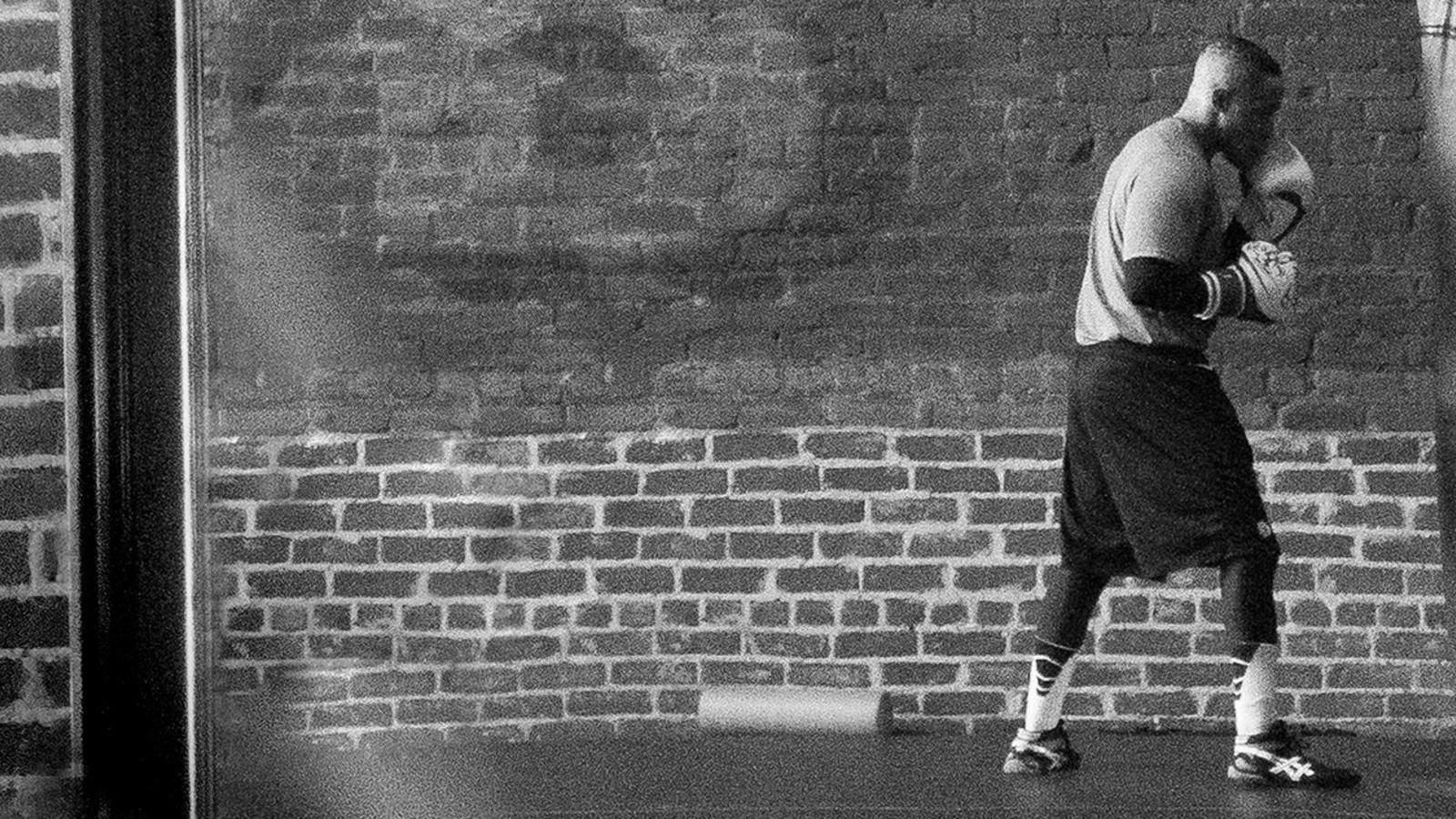
Men In The Mirror
Do The Latino Boxers In A Border Gym Know Something Other Men Don’t?
By Mary Lee Grant
Do The Latino Boxers In A Border Gym Know Something Other Men Don’t?
I am punching the bags at the Kingsville Boxing Club in Deep South Texas, the only Anglo and the only woman in the gym. It is a place of aspiration, a mix of professional boxers who make between $2,000 and $10,000 a fight, amateurs hoping to enter the big leagues and guys who drop by after work to punch the bags. Outside, the heat index is 107. Inside this abandoned tortilla factory with only two narrow windows and no air conditioning, it feels much hotter. Sweat drips into my eyes as I hit the heavy black bags with plastic Everlast gloves, slick with perspiration. The deep voice of salsa singer Celia Cruz resonates from crackly speakers though the cavernous old building.
The tattooed, muscled chests of the men moving next to me gleam as they grunt and grimace with every punch. Sweat gathers on the floor in pools that the boxers take turns mopping up. A sign reminds us: “Don’t spit on the floor.”
I have been practicing boxing at this mainly Mexican-American gym for two hours every day for the past year. Along the way, I have become close to men from both sides of the border, men who are boxing their way to a future they hope will bring them money and fame.
Mexican men may be the most maligned denizens of Trump’s America. Yet as I found myself growing ever more intimate with this group of macho athletes, I noticed qualities in them that the white men who are so quick to criticize might envy.
Watching them flex before the mirror, one throwing a glittery rosary around a neck, another perching a baseball cap at a studied sideways angle, I am reminded of the visual poverty that dominates the lives of most white men I know. I should point out that I am white and love many white men, so this is said with no ire. It is simply an observation, the musings of a woman who grew up as a minority in South Texas and watches with interest the differences between my own Anglo culture and the predominantly Mexican-American culture that formed me.
Unlike these vatos, white American men find few chances to relish their masculine beauty. Much ink has been spent on the rage of white men — school shooters, incels, suicides. Could white men be so angry in part because our society does not allow them the full expression of their masculinity?
We live in a society that says macho is toxic; some of its manifestations are so, profoundly. But perhaps our rules for masculinity are too limited. The result is a culturally enforced lack of style, panache and even physical grace, relentlessly mocked in popular culture from movies like “White Men Can’t Jump,” to country music, with songs like “If Bubba Can Dance, I Can Too,” and “Barney Jekyll & Bubba Hyde.”
Here at this border gym, I see something very different. I spend much of my time with men whose focus is the brute display of masculine power, who feel it is their calling to be warriors. And the anger and resentment against women that so often rears its head in the white professional world is absent here. Perhaps this arises in part because in the traditionally masculine fields in which many of them work — refineries, construction — women offer little competition. Unlike incels, who insist women must have the bodies of virginal 12-year-olds, these men enjoy women in their infinite variety. If the men at this gym have a problem with women, it is not that they hold them to impossible standards, but that they find too many of us attractive. I can’t help but wonder if their openness towards female beauty springs in part from embracing their own.
I am curious about what white men, constrained still by old Puritan ideals about excess and adornment in dress, might learn from Latino men, who come from a different strain of men’s style, one informed by the breezes of the Mediterranean. It is a sensibility shared by other men with cultures rooted in southern Europe, perhaps most flamboyantly Cretans, with their bandoliers, chapeaus, and styled moustaches. Perhaps if white men incorporated a bit of Latino style into their look, swag could become an everyday affair rather than an anomaly, a glass of wine with dinner instead of a drunken binge.
I see this style in the pride these boxers take in their bodies as well as their clothes. These are men who work out nine hours a day, jumping rope for an hour, running five miles twice a day, doing 100 sit-ups and a hundred pushups each day. And at a time when obesity rates are increasing among Americans, research has shown that overweight men face far more discrimination than those who aren’t obese.
In a study by Rice Business professor Mikki Hebl, overweight men were more likely to face casual discrimination than leaner men, both when shopping, and when serving as clerks at retail outlets. While past research has focused more on women and weight, it turns out that obesity affects how men are treated too.
“There is no doubt that I have self-confidence,” pro boxer Anthony Navarro told me. Like all professional boxers, Navarro watches his weight carefully so he doesn’t have to jump up to a higher weight class and fight bigger guys. He even sweats off final pounds in a sauna so he can make weight before a big bout. Navarro combines this body consciousness with a styled casual look, distinguished by bald head, tattooed backward baseball cap, white shirt, baggy jeans and Gangsta Nikes.
“Sometimes I see a really preppy white guy and I think, ‘That looks good. I could wear that,’” Navarro said. “But I notice they don’t wear as much jewelry and I really enjoy my jewelry. I got my ears pierced really young, just like my father. I wear gold chains. I have a black and silver rosary I really like. Sometimes, I wear it into the ring.”
The world of Latino boxing is one of grit, flash and corazon, or heart. Each boxer has a boxing persona, often correlating with his ethnic identity or nationality. One may walk out to fight in a sequined sombrero, another in Mexican flag shorts, accompanied by traditional Mexican tunes like Vicente Fernandez’s “El Palenque."
Their ring names exemplify hyped-up masculinity. I know three different men with rooster names: El Gallo Negro, El Gallo Giro, and El Gallo Fino. For all of them, the glitz and toughness of the boxing world carry over into their daily style. Outside the gym, for example, boxer “Toro” Herrera De La Paz sports a variety of looks, from fancy suit with green tie and matching green vest, to a sleeveless Lakers shirt showing his toned, arms paired with a blue and white rosary and blue and white cap. “I think it is all about having brown pride on you,” De La Paz said.
And while white men complain of feeling oppressed and aggrieved by American society, these men, who work as custodians, nursing home aides and ditch diggers, look at their own reflection with pride. In the tradition of Charles Atlas, transforming himself from a scrawny weakling into a muscle man, they stand with confidence, despite — maybe inspired by — having sand constantly kicked in their face by the dominant society.
A big part of this style, several boxers told me, is not physical prowess but attitude. “My grandmother always told me I have too much pride, because I don’t back down, but I think that is also part of the way you carry yourself,” said “Baby Jesus” Moreno who works out occasionally at the gym. “My main advice to white men is to relax. They don’t seem to feel at ease with themselves. You know, comfortable in their own skins. Also they might consider more bling.”
With all the talk of style, it may seem strange that carrying a baby is considered an excellent look by these men. But children play a key role at this boxing gym, crawling in and out of the ring, hanging on the ropes and watching their dads spar. Professional boxer Omar Rojas said he has been taking his son into the ring since he began to crawl, keeping an eye on him while he practices. Little girls in pink dresses with bows in their hair run between the punching bags, occasionally pounding them alongside the toughest of men. I have often seen these guys, with their hands wrapped, ready to put on boxing gloves, carrying a toddler out of harm’s way.
This comfort with the presence of children is not, of course, exclusive to Latino culture. But Latino tradition may encourage it. Navarro said his love of kids in no way counteracts his tough image. “If anything, I am more macho with a child in my arms,” he said. “Having children changed my life and turned me away from the streets. The most important thing for me is to be a role model to the little ones, both my own children and others. Plus, you know if they are here at the gym with us, they aren’t getting into trouble.” (Journalist Claudia Kolker addresses children in public life in the Latin American plaza in her book, The Immigrant Advantage: What We Can Learn from Newcomers to America about Health, Happiness and Hope.)
Spending much of my life as a journalist on the border, I have observed the daily horrors of machismo as I compiled the police blotter in hardscrabble towns whose names no one north of Corpus Christi would recognize. “Subject threw multiple unopened cans of Bud Light at female victim's face, then pushed her backward off porch. Subject said he was acting in self-defense. Victim transported to hospital. Victim chose not to press charges at this time.” It is no accident that many Latinas prefer to date and marry white men. Yet these boxers have shown me another side of Mexican masculinity. On these arid South Texas plains, I see displayed valor and dreams of glory worthy of a Cervantes hero.
And although a recommendation of “more bling” might seem a superficial solution to the existential crisis some white men face, perhaps the seemingly superficial can act transformatively. Actions seem to follow feeling, William James famously wrote, but actually the two are intertwined. “By regulating the action, which is under the direct control of the will, we can indirectly regulate the feeling, which is not. Thus the sovereign path to cheerfulness, if our cheerfulness be lost, is to sit up cheerfully and to act and speak as if cheerfulness were already there.”
Or as 12-step programs would have it, “fake it 'til you make it.” Maybe white men can imitate Latino style until they internalize it. Then Mexican macho swag will become as American as fajitas and breakfast tacos.
Mary Lee Grant has a degree in history from Yale University and a PhD from Texas A&M University, specializing in Mexican-American history and gender history.


